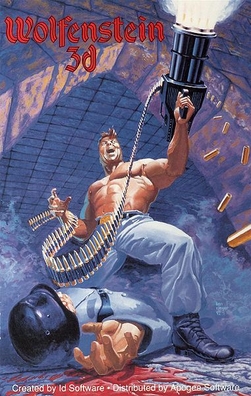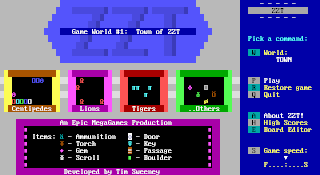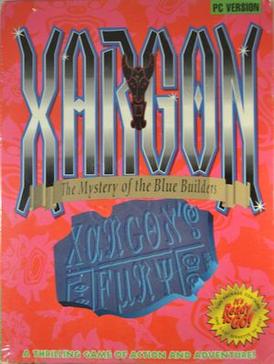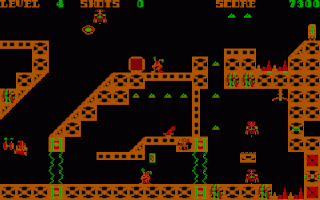
Rise of the Triad: Dark War is a first-person shooter video game, developed and published by Apogee Software in 1995. The player can choose one of five different characters to play as, each bearing unique attributes such as height, speed, and endurance. The game's story follows these five characters who have been sent to investigate a deadly cult, and soon become aware of a deadly plot to destroy a nearby city. Its remake was designed by Interceptor Entertainment and released by Apogee Games in 2013. The shareware version of the game is titled Rise of the Triad: The HUNT Begins.

Wolfenstein 3D is a first-person shooter video game developed by id Software and published by Apogee Software and FormGen. Originally released on May 5, 1992, for DOS, it was inspired by the 1981 Muse Software video game Castle Wolfenstein, and is the third installment in the Wolfenstein series. In Wolfenstein 3D, the player assumes the role of Allied spy William "B.J." Blazkowicz during World War II as he escapes from the Nazi German prison Castle Wolfenstein and carries out a series of crucial missions against the Nazis. The player traverses each of the game's levels to find an elevator to the next level or kill a final boss, fighting Nazi soldiers, dogs, and other enemies with a knife and a variety of guns.
Commander Keen is a series of side-scrolling platform video games developed primarily by id Software. The series consists of six main episodes, a "lost" episode, and a final game; all but the final game were released for MS-DOS in 1990 and 1991, while the 2001 Commander Keen was released for the Game Boy Color. The series follows the eponymous Commander Keen, the secret identity of the eight-year-old genius Billy Blaze, as he defends the Earth and the galaxy from alien threats with his homemade spaceship, rayguns, and pogo stick. The first three episodes were developed by Ideas from the Deep, the precursor to id, and published by Apogee Software as the shareware title Commander Keen in Invasion of the Vorticons; the "lost" episode 3.5 Commander Keen in Keen Dreams was developed by id and published as a retail title by Softdisk; episodes four and five were released by Apogee as the shareware Commander Keen in Goodbye, Galaxy; and the simultaneously developed episode six was published in retail by FormGen as Commander Keen in Aliens Ate My Babysitter. Ten years later, an homage and sequel to the series was developed by David A. Palmer Productions and published by Activision as Commander Keen. Another game was announced in 2019 as under development by ZeniMax Online Studios, but was not released.

ZZT is a 1991 action-adventure puzzle video game and game creation system developed and published by Potomac Computer Systems for MS-DOS. It was later released as freeware in 1997. It is an early game allowing user-generated content using object-oriented programming. Players control a smiley face to battle various creatures and solve puzzles in different grid-based boards in a chosen world. It has four worlds where players explore different boards and interact with objects such as ammo, bombs, and scrolls to reach the end of the game. It includes an in-game editor, allowing players to develop worlds using the game's scripting language, ZZT-OOP.

Unreal Engine (UE) is a series of 3D computer graphics game engines developed by Epic Games, first showcased in the 1998 first-person shooter video game Unreal. Initially developed for PC first-person shooters, it has since been used in a variety of genres of games and has been adopted by other industries, most notably the film and television industry. Unreal Engine is written in C++ and features a high degree of portability, supporting a wide range of desktop, mobile, console, and virtual reality platforms.

Epic Games, Inc. is an American video game and software developer and publisher based in Cary, North Carolina. The company was founded by Tim Sweeney as Potomac Computer Systems in 1991, originally located in his parents' house in Potomac, Maryland. Following its first commercial video game release, ZZT (1991), the company became Epic MegaGames, Inc. in early 1992 and brought on Mark Rein, who has been its vice president since. After moving the headquarters to Cary in 1999, the studio changed its name to Epic Games.

Timothy Dean Sweeney is an American video game programmer and businessman. He is the founder and CEO of Epic Games, and the creator of Unreal Engine, a game development platform.

Blood is a 3D first-person shooter video game developed by Monolith Productions and published by GT Interactive and developed using Ken Silverman’s Build engine. The shareware version was released for MS-DOS on March 7, 1997, while the full version was later released on May 21 in North America, and June 20 in Europe.

Jazz Jackrabbit 2 is a 1998 platform game produced by Epic MegaGames. It was released for Windows, and later for Macintosh. Like the first game, Jazz Jackrabbit, Jazz Jackrabbit 2 is a side-scrolling platform game but features additional multiplayer options, including the ability to play over a LAN or the Internet. The game was re-released on GOG.com along with the first game on November 30, 2017.

Duke Nukem is a 1991 platform game developed and published by Apogee Software for MS-DOS. The 2D, multidirectional scrolling game follows the adventures of fictional character Duke Nukem across three episodes of ten levels each. The game's first episode was distributed as shareware. The name was briefly changed to Duke Nukum to avoid trademark issues.

Xargon: The Mystery of the Blue Builders is a video game trilogy produced by Epic MegaGames for DOS. The game is a side-scrolling platform game. The main character, Malvineous Havershim, must journey through strange landscapes as he seeks to destroy the evil Xargon.

Jazz Jackrabbit is a 1994 platform game developed and published by Epic MegaGames. It was released for MS-DOS-based computers. The game was re-released on GOG.com along with Jazz Jackrabbit 2 on November 30, 2017, with support for Windows, macOS, and Linux.

Epic Pinball is a 1993 pinball video game developed by James Schmalz and published by Epic MegaGames. The initial release pre-dated Schmalz' Digital Extremes name. The game is played seen from a 2D top-down view within a scrollable window with plain raster graphics in 320x240. It was noted for being programmed entirely in x86 assembly language for MS-DOS systems.

Monuments of Mars is a third-person puzzle-platform game developed by Scenario Software for MS-DOS and compatible systems. It was published by Apogee Software. The game consists of four 20-level episodes, the first episode being shareware, the rest being commercial software. It is similar to the games Arctic Adventure and Pharaoh's Tomb but uses an unrelated engine.
Vinyl Goddess from Mars is a 2D platform game published by Union Logic Software Publishing, Inc and developed by Six Pound Sledge Studios. It was released for DOS in 1995.

Commander Keen in Invasion of the Vorticons is a three-part episodic side-scrolling platform video game developed by Ideas from the Deep and published by Apogee Software in 1990 for MS-DOS. It is the first set of episodes of the Commander Keen series. The game follows the titular Commander Keen, an eight-year-old child genius, as he retrieves the stolen parts of his spaceship from the cities of Mars, prevents a recently arrived alien mothership from destroying landmarks on Earth, and hunts down the leader of the aliens, the Grand Intellect, on the alien home planet. The three episodes feature Keen running, jumping, and shooting through various levels while opposed by aliens, robots, and other hazards.

Commander Keen in Goodbye, Galaxy is a two-part episodic side-scrolling platform video game developed by id Software and published by Apogee Software in 1991 for DOS. It consists of the fifth and sixth episodes of the Commander Keen series, though they are numbered as the fourth and fifth, as Commander Keen in Keen Dreams is not part of the main continuity. The game follows the titular Commander Keen, an eight-year-old child genius, as he first journeys through the Shadowlands to rescue the Gnosticenes so they may ask the Oracle how the Shikadi plan to destroy the galaxy, and then through the Shikadi's Armageddon Machine to stop them. The two episodes feature Keen running, jumping, and shooting through various levels while opposed by aliens, robots, and other hazards.

Commander Keen in Aliens Ate My Babysitter is a side-scrolling platform video game developed by id Software and published by FormGen in December 1991 for DOS. It is the seventh episode of the Commander Keen series, though it is numbered as the sixth, as Commander Keen in Keen Dreams is outside of the main continuity. The game follows the titular Commander Keen, an eight-year-old child genius, as he journeys through an alien world to rescue his kidnapped babysitter. The game features Keen running, jumping, and shooting through various levels while opposed by aliens, robots, and other hazards.

The Epic Games Store is a video game digital distribution service and storefront operated by Epic Games. It launched in December 2018 as a software client, for Microsoft Windows and macOS, and online storefront. The service provides friends list management, game matchmaking, and other features. Epic Games has further plans to expand the feature set of the storefront but it does not plan to add as many features as other digital distribution platforms, such as discussion boards or user reviews, instead using existing social media platforms to support these.

















